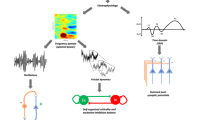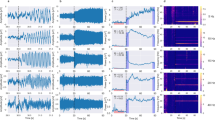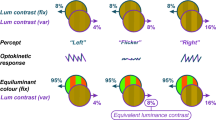Abstract
SCALP potentials evoked by sinusoidally modulated light have been measured for various monochromatic stimuli of equal retinal illuminations. The correlation apparatus made use of the orthogonality of sinusoids to extract from the electroencephalogram the sinusoidal evoked component at stimulus frequency (synchronous component), and to measure its amplitude and phase1,2. It was found that if the light stimulus were viewed with good voluntary fixation, and if its frequency and peak intensity were accurately maintained constant, an average steady-state régime occurred from about 12–20 sec after stimulus onset until at least 70 sec, during which the running average of the amplitude and phase of the synchronous component remained constant1. Data for one subject are described.
This is a preview of subscription content, access via your institution
Access options
Subscribe to this journal
Receive 51 print issues and online access
$199.00 per year
only $3.90 per issue
Buy this article
- Purchase on SpringerLink
- Instant access to full article PDF
Prices may be subject to local taxes which are calculated during checkout
Similar content being viewed by others
References
Regan, D., Electroenceph. Clin. Neurophysiol. (in the press).
Regan, D., Med. Electron. Biol. Eng. (in the press).
van der Tweel, L. H., Docum. Ophthal. (Den Haag), 18, 287 (1964).
van der Tweel, L. H., Electroenceph. Clin. Neurophysiol., 18, 587 (1965).
Author information
Authors and Affiliations
Rights and permissions
About this article
Cite this article
REGAN, D. An Effect of Stimulus Colour on Average Steady-state Potentials evoked in Man. Nature 210, 1056–1057 (1966). https://doi.org/10.1038/2101056a0
Issue date:
DOI: https://doi.org/10.1038/2101056a0
This article is cited by
-
Optimal flickering light stimulation for entraining gamma waves in the human brain
Scientific Reports (2021)
-
A resource for assessing information processing in the developing brain using EEG and eye tracking
Scientific Data (2017)
-
A frequency-tagging electrophysiological method to identify central and peripheral visual field deficits
Documenta Ophthalmologica (2014)
-
Identification of a novel dynamic red blindness in human by event-related brain potentials
Journal of Huazhong University of Science and Technology [Medical Sciences] (2010)
-
Modulation of steady-state auditory evoked potentials by cerebellar rTMS
Experimental Brain Research (2006)



